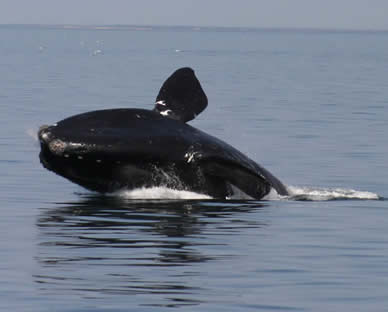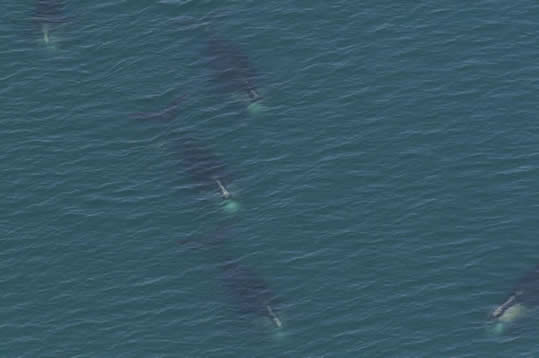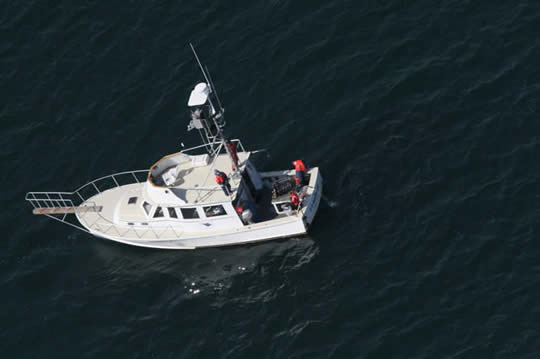April 2009
27 April . SW742 was directed at documenting a large aggregation of right whales through photo ID, behavioral recording and resource sampling. The aggregation was located along the north-central margin of Cape Cod Bay, west of Race Point. Approximately 15-18 right whales with three mother calf pairs, 36-41 humpback whales, six fin whales, two minke whales, 30-60 Atlantic white-sided dolphins, one harbor seal and one grey seal were recorded. Many of the whales appeared to be going on high fluking dives, indicating that the whales were possibly feeding at depth.
Towards the mid-afternoon an easterly wind increased and sea conditions worsened to a Beaufort state 3 thus impeding our sampling effort. Surface and oblique sampling demonstrated that the food resource was minimal and rough seas prohibited the team from conducting vertical sampling that may have revealed a dense layer at or towards the sea bottom. Towards the end of our cruise the team observed a surface active group in which one right whale calf hesitantly participated. The habitat team hopes to cruise in the next few days to document the prey resource in Cape Cod Bay.
26 April . The habitat team conducted SW741 with optimal sea state and weather conditions. Sampling was carried out at all nine regular sampling stations. Although the team observed a diversity of marine life, only one right whale was recorded in the southern end of Cape Cod Bay. Five large groups of Atlantic white-sided dolphins, five harbor porpoises, 16 harbor seals, three grey seals, 15 fin whales, 11 minke whales and 34-35 humpbacks were observed.
In addition to observing myriad marine life, the habitat team found and collected several mylar foil balloons from Cape Cod Bay. Mylar balloons are known to persist in the marine environment and are hazardous to various marine mammals found in the Bay. Marine mammals that feed primarily on jellyfish such as sea turtles (leatherback and loggerhead) frequently mistake the balloons for prey and ingest the harmful plastic. Over time, ingestion of plastics may block the digestive system, leading to mortality.
Zooplankton samples revealed that the food resource appears to be declining, with the majority of the zooplankton concentrated in the southern part of the bay. The habitat team is interested to see if the zooplankton resource will continue to steadily decline and if the right whales will stay out of the bay. It is common for North Atlantic right whales to leave the bay around the middle of May to make their way further north to their summer feeding ground in the Bay of Fundy.
18 April . A second consecutive nice day allowed us to do our track lines east of Cape Cod. Compared to what has been seen in the bay, we saw relatively low numbers, with very few, if any, sightings in the northern section. As we worked our way further south we were excited to come across a SAG with two adults and one calf! The calf was born earlier this year in the warm waters off of the Georgia/Florida coast. It will continue to spend the rest of the year with its mom before it weans from her milk.
Our next sighting was of approximately 8 fin whales. These whales are the second biggest animals in the world, and we were lucky to see them lunge feeding on their sides, with their ventral pleats completely expanded. Fin whales are part of a family of whales called the rorquals, which means that they have pleats on the under sides of their mouths allowing them to expand their mouths much the same way a pelican expands its pouch while feeding. This allows them to take in more water and fish with every mouthful. Fin whales can also swim extremely fast, reaching burst speeds of up to 28 mph, which is how they got their nickname “the greyhounds of the seaâ€. We finished our survey with one more right whale skim feeding at the surface.

18 April . Today’s cruise plan had us depart Provincetown Harbor shortly past 0900 with an idea to focus investigations towards describing the vertical and horizontal distribution and composition of prey resources around feeding whales in the southern quadrant of the bay. Yesterday, the aerial team sighted nearly 70 whales in this part of the bay skim and subsurface feeding on a rich plankton resource, even reporting a visible orange slick (dense concentrations of lipid-rich copepods) from the air. As the day’s forecast called for rain and moderate winds (variable; 5-15 kts) coming from the west and moving around to the east later in the day, the team took advantage of an opportunity to conduct a directed study on finer-scale zooplankton dynamics in the southern section of the bay.

An orange plankton slick visible from the air.
Numerous sightings of marine species, including several species of large whales (humpback, right, fin, minke), dolphins and seals were made. We also observed whales breaching, sometime 4-5 times in succession. A total of 26-43 right whale sightings, including some duplicates, were photographed and recorded throughout the day. We observed right whales subsurface feeding in the morning and skim feeding by late afternoon in the shallow waters of the far south.
Conditions in this portion of the bay were rich enough over a wide area to elicit feeding and aggregation by right whales, but our sampling – including four vertical pump samplings, five plankton tows, one in-path pump sample and two long horizontal transects – revealed zooplankton concentrations at any one depth and location were not exceptionally dense. This variable prey patch dynamic is of particular importance to better understanding and forecasting the numbers of, and behaviors for feeding/aggregating right whales here in the bay.
The prey resource for right whales has progressed from one dominated by Pseudocalanus spp. to one dominated by Calanus finmarchicus, and particularly later-stage Calanus. The seasonal progression in species composition, and in stage (i.e. moult ‘size’) for a copepod assemblage is typical for Cape Cod Bay. Stage IV, V, and adult Calanus, which are more lipid-dense, are likely to be of highest caloric ‘benefit’ to right whales. Although we found a more diffuse zooplankton layer occupying the upper 5-8 meters of the water column today, we hypothesize that caloric availability has been sufficient to maintain the numbers and smaller aggregations of subsurface and skim feeding right whales that have been documented the past few weeks. It will be of interest to document if and when the peak of this late-stage Calanus resource occurs and how it will affect the timing of departure of whales from the bay in May.

Right whale breaching near the R/V Shearwater.
17 April . Low winds in the morning gave us an opportunity for an earlier take-off on Friday morning. This time, we started in southern Cape Cod Bay where we had spotted a dense aggregation of whales at the end of Tuesday’s flight. Sure enough, we had no sooner started our first trackline when we spotted our first group of feeding right whales. Unlike the long-diving whales of our previous survey, this bunch stayed right at the surface, skim-feeding on a surface layer of zooplankton. The plankton was so dense in places that the water appeared cloudy and orange-tinged. The orange coloration of the copepod, the right whales’ primary source of food comes from the energy-rich lipid sac in the flea-sized crustaceans’ bodies which supply the whale with its caloric needs.
Many whales were also feeding in an echelon formation. This is characterized by one whale leading a line of whale feeding at varied depth, presumably to maximize the amount of plankton each whale ingests. We continued to see groups of whales engaged in this coordinated feeding as we criss-crossed the southern portion of the bay. After spending all morning circling on over 70 whales, including at least three mother and calf pairs, we landed to refuel. Our afternoon, however, was drastically different from the mornings’ excitement, with only one right whale sighting, also in the southern half of the bay. As the afternoon progressed, the wind picked up, and our ability to spot whales was hindered. Despite the high sea state, we did manage to spot at least five fin whales, several humpbacks, one minke, and hundreds of Atlantic white-sided dolphins.
14 April . On Tuesday morning we took off from Chatham airport and started our survey by flying our trackline up the backside of Cape Cod, three miles east of the coastline. We saw spouts almost right away, but upon closer investigation, they turned out to be fin whales and humpbacks. Amongst these larger whales, we also saw hundreds of Atlantic white-sided dolphins, a species which continued to appear throughout the trip!
Our first right whale was sighted in the middle of the bay, west of Provincetown, and soon, others began to appear as well. The right whales in the north of the bay proved challenging to photograph. After a brief surfacing, they would then go on deep dives, sometimes not coming up again for almost 20 minutes! When they did surface, they often brought a billowing cloud of mud with them, suggesting that they are foraging for food on the ocean floor.
As evening approached, we found ourselves in the southern portion of the bay where we came across at least 15 more right whales. This time, they were feeding at the surface, or “skim-feedingâ€, making them much easier to photograph and document. The whales were feeding in almost a horse-shoe shape pattern. As the sun began to set we had to cut our survey short and head back to the airport, but we are hoping for a good weather window later this week to see if the whales stay in the south or follow the resource to other parts of the bay.

Right whales socialize as an Atlantic white-sided dolphin swims away.
14 April . PCCS’s habitat studies team conducted its 12th research cruise of the season with excellent weather and sea conditions. With the completion of a bay-wide survey on Friday April 10th, SW739 was dedicated to understanding the vertical structure of zooplankton in Cape Cod Bay. Intensive vertical pump sampling was conducted, whereby zooplankton samples were taken at discrete depths in the water column. A diversity of marine life was observed with 50-100 Atlantic white-sided dolphins, 6-7 harbor seals, 1 humpback whale, 5-6 fin whales and 22-27 right whales recorded from the R/V Shearwater. Results from the vertical pump sampling revealed that Calanus finmarchicus was the dominating food resource and was found at varying depths in the water column. Right whale behavior coincided with the location of the food resource, as both high and long fluking dives (suggestive of bottom feeding) and sub-surface feeding was observed.
In order to gain a better understanding of how the vertical distribution of zooplankton places right whales at increased risk of mortality due to ship strike and entanglement in fishing gear, the habitat studies team is investigating the daily migration of zooplankton in Cape Cod Bay. Zooplankton are thought to avoid illuminated surface waters to prevent predation from visual predators such as fish. When surface waters are no longer illuminated, zooplankton are thought to exploit phytoplankton (microscopic algae) resources. If zooplankton in Cape Cod Bay perform DVM (Diel Vertical Migration), right whales may be at increased risk of ship strike in the evening and of increased risk of entanglement in fishing gear found at the sea floor during the day.
10 April . On Friday we flew a complete survey from north to south, and immediately got a taste of what the day would be like with a wide variety of life spotted from our trackline off the backside of the Cape including minkes, fin whales, humpbacks, and dolphins. This high diversity continued throughout the day for a total of 22 fin whales, 20 humpbacks, and at least 50 dolphins observed. We also saw 47 right whales, concentrated almost exclusively in the central portion of the Bay.
Most of the whales were subsurface feeding, though we did encounter one surface active group (SAG) of 5 right whales. Among these 47, at least 15 new individuals for the season were identified, which can indicate that the whales are still arriving into the area.
Some additional highlights included a large congregation of at least 20 right whales feeding just east of Truro and our first mom/calf pair of the season! After landing and taking a look at our photographs, we identified the mother as 2145, and learned that her calf had survived a shark bite that occurred down in the calving grounds off the coasts of Florida and Georgia. We’re hoping this pair will stick around a bit longer for us to get better photo documentation of the calf.

Right whales sub-surface feeding near Truro.
10 April . After several days of high winds and rough seas, the habitat team found a window of opportunity to conduct a bay-wide survey. Optimal sampling conditions allowed for sampling at all 9 stations and for special sampling in the presence of feeding whales. Marine mammal sightings were diverse, with approximately 4 harbor seals, 5 fin whales, 1-2 humpback whales, 40-60 Atlantic white-sided dolphins, 10-20 harbor porpoises and 15-20 right whales recorded.
The team observed a social group of approximately 3 individuals, amongst the group was a whale named Ruffian. Ruffian was photographed in Cape Cod Bay in 2008 with large wounds on his back. The habitat team watched as Ruffian engaged in sporadic sub-surface feeding beside the boat and was pleased to see that he appears to be healing.
Towards the end of the day a large and energy-rich prey patch was located in the eastern quadrant of Cape Cod Bay with approximately 15 feeding whales. The right whales were observed sub-surface and skim-feeding in the prey patch and results from a zooplankton samples taken in the path of a feeding whale revealed that the whales were most likely feeding on Calanus finmarchicus. In future studies, the habitat team hopes to investigate the environmental and oceanographic conditions responsible for the formation and durability of prey patches, such as the one observed today.

The R/V Shearwater conducting a plankton tow.
09 April . On Thursday we did our first survey in almost two weeks. The bad weather has kept us grounded for a while, but in the mean time we received a new plane to use. N6263F just finished flying the right whale field season in Florida, where aerial teams were documenting the new mother/calf pairs for 2009. This year set a new record with 39 calves born. This number blew the previous record of 31 calves out of the water.
Every year pregnant females make the long migration south to the warm waters off of the Georgia and Florida coast. A number of the mothers this year are Cape Cod Bay whales so we are hoping to see them and their new calves at some point in the next few weeks. Unfortunately, our new plane did not bring nice calm waters from Florida with it, and we were battling rough seas the whole survey. The conditions made for less than desirable working conditions. We were still able to find 10 individual right whales before we had to cut our survey short and land due to weather. Even though we had to land early, and it was the least amount of whales we have seen in weeks, we were still excited to know that there are still whales in the area.
 01 April . The right whale habitat studies team conducted Shearwater cruise SW737 with moderate seas, good visibility and overcast skies. The purpose of the cruise was to document the food resource and to photo-document right whales observed in Cape Cod Bay. 14 right whales, three harbor seals, four fin whales and one unidentified large whale were sighted in the bay. It appears as though a portion of the 60 whales seen in Cape Cod Bay two weeks ago have moved outside of the Bay.
01 April . The right whale habitat studies team conducted Shearwater cruise SW737 with moderate seas, good visibility and overcast skies. The purpose of the cruise was to document the food resource and to photo-document right whales observed in Cape Cod Bay. 14 right whales, three harbor seals, four fin whales and one unidentified large whale were sighted in the bay. It appears as though a portion of the 60 whales seen in Cape Cod Bay two weeks ago have moved outside of the Bay.
IMG_0040adjusted.jpgZooplankton sampling of all nine regular sampling stations and at three special stations revealed that the controlling food resource was found in the western portion of the bay with a dominance of late-stage Calanus finmarchicus. A declining Pseudocalanus ssp. resource was found in the eastern portion of the bay. Right whales were seen low-skim feeding and sub-surface feeding on small prey patches of both Calanus finmarchicus and Pseudocalanus ssp.
Sub-surface feeding is a particularly dangerous feeding behavior as it places right whales at increased risk of vessel strike. Mariners often cannot detect the presence of a sub-surface feeding right whale and therefore the risk of collisionIMG_0039 copy.JPG is increased. In an effort to mitigate against anthropogenic mortality due to vessel strike, the habitat team produces ship strike alerts for the Massachusetts Division of Marine Fisheries, who disseminates this information to the Massachusetts Environmental Police and the US Coast Guard who are responsible for enforcing the state mandated speed restrictions in Cape Cod Bay. The habitat team is interested to see if a strong Calanus finmarchicus resource will be advected in from the Gulf of Maine to support large feeding aggregations in the Bay.

Our Work
Humpback Whale Research
Right Whale Research
Marine Animal Entanglement Response
Marine Geology Department
Water Quality Monitoring Program
Marine Fisheries Research
Seal Research
Shark Research
Marine Education
Interdisciplinary
Marine Debris and Plastics Program
Marine Policy Initiative
Cape Cod Climate Change Collaborative
Publications

